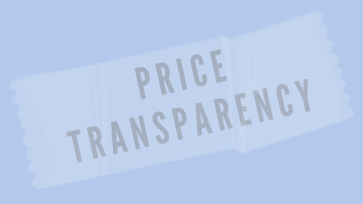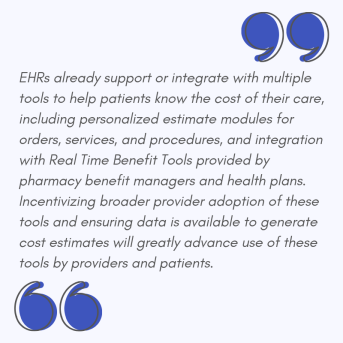 On June 3, the public comment period on ONC’s NPRM implementing health IT provisions of the 21st Century Cures Act closed. These comment windows offer a unique opportunity to gain a broader perspective on the state of the health IT industry.
On June 3, the public comment period on ONC’s NPRM implementing health IT provisions of the 21st Century Cures Act closed. These comment windows offer a unique opportunity to gain a broader perspective on the state of the health IT industry.
Upon our review of the feedback submitted to ONC, an overwhelming trend emerged—nearly 55% of the 2,013 comments were from individual patients commenting in favor of increased price transparency in the healthcare industry. Patients shared stories of the challenges they faced in determining the cost of treatment before receiving care, and dozens expressed the shock and financial hardship they experienced when they received a bill for their care.
In the months since the public comment window closed, we’ve seen this demand for healthcare price transparency gain attention across the industry. President Trump issued an executive order, and the Senate is considering the “Lower Health Care Costs Act,” legislation that aims to improve patient access to price information in the healthcare industry.
While ONC’s NPRM didn’t include any specific provisions about price transparency, it did include two requests for information:
- Should pricing data be considered Electronic Health Information (EHI)?
- What barriers exist to achieving price transparency in health care?
So what are the answers, and how can health IT help address this concern?
Including Pricing Data as EHI
The concept of explicitly including pricing information in the definition of EHI was perhaps the most commonly commented-on topic of ONC’s NPRM, and one that commenters overwhelmingly opposed.
Stakeholders highlighted that including price and payment data as EHI would have unintended consequences. For example, many providers gave feedback informing ONC that they are contractually bound to keep negotiated rates confidential; if pricing data was suddenly considered EHI, to which expectations would they adhere?
While the EHR Association shared the concerns of those stakeholders in our public comments to ONC, our members support increased adoption of tools that promote price transparency.
EHRs already support or integrate with multiple tools to help patients know the cost of their care, including personalized estimate modules for orders, services, and procedures, and integration with Real Time Benefit Tools provided by pharmacy benefit managers and health plans. Incentivizing broader provider adoption of these tools and ensuring data is available to generate cost estimates will greatly advance use of these tools by providers and patients.
Addressing Barriers to Achieving Price Transparency in Healthcare
Health IT developers have supported tools to provide patients with price estimates for years. However, whether patients and providers are able to take advantage of these tools depends on a number of factors including:
- The availability of negotiated rate data for each of the health plans accepted by the provider organization in a machine-readable format
- The extent to which connected systems have adopted content and terminology standards
- Prioritization by the provider organization to complete necessary technical/workflow implementation steps and staff training
 To advance price transparency, ONC should promote the adoption of standards-based functionality of health IT that allows for real-time estimate creation across stakeholders. Standards are available to make medication price information available to patients, but adoption is not consistent across payers, PBMs, and provider organizations. For example, Allina Health in Minnesota prioritized implementation of a real-time pharmacy benefit tool in its system, but found that it can only provide estimates for about 50% of patients due to inconsistent data availability.
To advance price transparency, ONC should promote the adoption of standards-based functionality of health IT that allows for real-time estimate creation across stakeholders. Standards are available to make medication price information available to patients, but adoption is not consistent across payers, PBMs, and provider organizations. For example, Allina Health in Minnesota prioritized implementation of a real-time pharmacy benefit tool in its system, but found that it can only provide estimates for about 50% of patients due to inconsistent data availability.
Extrapolating the effort needed to build consensus among stakeholders (e.g. pharmacies, labs, diagnostic imaging, etc.) suggests it is likely to be challenging to bring price transparency to healthcare. However, consistent adoption of standards and availability of data could greatly accelerate stakeholders towards making meaningful price estimates available to patients.
Recommendations for Next Steps
Patients deserve to know how much their care will cost. Studies have also indicated that when pricing data is available within clinicians’ workflow, they choose the most cost effective treatment option. However, the implementation of price estimate tools is complex and requires a nuanced strategy.
We recommend the following phased approach to promoting price transparency:
- Prioritize implementation. Certain types of information (such as medications) are much further along with respect to standards and exchange of price information than other types of information (such as labs). Industry should focus consistently on certain types of information on the same schedule.
- Assess the availability and adoption of standards to meet each component. Incentivize development of standards where they are insufficient.
- Convene stakeholders including health IT developers, providers, payer organizations, and intermediaries (such as PBMs, Clearinghouses, etc.) to determine reasonable timelines for implementation of technical capabilities.
- Incentivize adoption of tools in both clinician and patient-facing venues.
Healthcare price transparency is a worthwhile goal. Through agreed-upon standards, intra-industry collaboration and a stepped-up approach, it’s a goal we can achieve.
